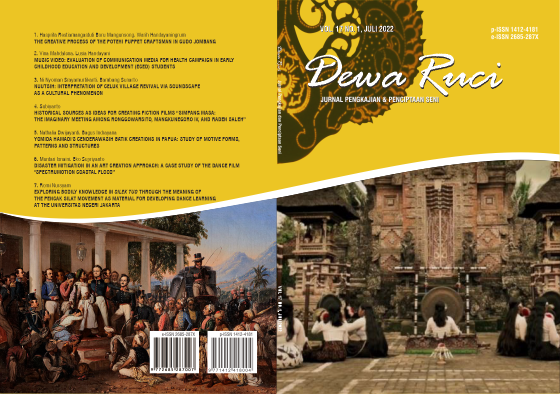Nuutsih: interpretation of Celuk village revival via soundscape as a cultural phenomenon
Main Article Content
Abstract
Downloads
Article Details
Authors who publish in Dewa Ruci: Jurnal Pengkajian dan Penciptaan Seni agree to the following terms:
- Authors retain copyright and grant the Dewa Ruci: Jurnal Pengkajian dan Penciptaan Seni right of first publication with the work simultaneously licensed under a Creative Commons Attribution License (CC BY-SA 4.0) that allows others to share (copy and redistribute the material in any medium or format) and adapt (remix, transform, and build upon the material) the work for any purpose, even commercially with an acknowledgment of the work's authorship and initial publication in Dewa Ruci: Jurnal Pengkajian dan Penciptaan Seni.
- Authors are able to enter into separate, additional contractual arrangements for the non-exclusive distribution of the journal's published version of the work (e.g., post it to an institutional repository or publish it in a book), with an acknowledgment of its initial publication in Dewa Ruci: Jurnal Pengkajian dan Penciptaan Seni.
- Authors are permitted and encouraged to post their work online (e.g., in institutional repositories or on their website) prior to and during the submission process, as it can lead to productive exchanges, as well as earlier and greater citation of published work (See The Effect of Open Access).
This work is licensed under a Creative Commons Attribution 4.0 International License
References
Y. Abdillah, S. Supriono, and B. Supriyono, “Change and innovation in the development of Balinese dance in the garb of special interest tourism,” Cogent Soc. Sci., vol. 8, no. 1, Dec. 2022, doi: 10.1080/23311886.2022.2076962.
N. N. S. Wisudawati and A. A. I. A. Maheswari, “Potential of Silver Craft Product through to Community-Based for Tourism Sustainability in Celuk Village,” Int. Res. J. Manag. IT Soc. Sci., vol. 5, no. 1, pp. 9–15, 2018. doi: 10.21744/irjmis.v5i1.588
I. G. Santosa, M. Yusuf, I. N. Gunung, and I. K. Rimpung, “Application of Forging Hammer to Increases Productivity of Balinesse Blacksmith,” in International Conference on Innovation in Science and Technology (ICIST 2020), 2021, pp. 195–199, doi: 10.2991/aer.k.211129.043.
B. Truax, “R. Murray Schafer (1933–2021) and the World Soundscape Project,” Organised Sound, vol. 26, no. 3, pp. 419–421, Dec. 2021, doi: 10.1017/S1355771821000509.
S. S. Johansen, N. van Berkel, and J. Fritsch, “Characterising Soundscape Research in Human-Computer Interaction,” in Designing Interactive Systems Conference, 2022, pp. 1394–1417, doi: 10.1145/3532106.3533458.
J. Kang, “Soundscape: Progress in the past 50 years and challenges in the next 50 years,” INTER-NOISE NOISE-CON Congr. Conf. Proc., vol. 263, no. 6, pp. 132–139, Aug. 2021, doi: 10.3397/IN-2021-1302.
M. Solomos, “From sound to sound space, sound environment, soundscape, sound milieu or ambiance,” Paragraph, vol. 41, no. 1, pp. 95–109, 2018. doi: 10.3366/para.2018.0253
B. Tribun, “Kerajinan Perak dan Emas Celuk Dapat Sertifikasi IG,” Bali Tribun, 2019. [Online]. Available: balitribune.co.id.
C. Walker, “‘Generation Z’ and ‘ second generation’: an agenda for learning from cross-cultural negotiations of the climate crisis in the lives of second generation immigrants,” Child. Geogr., vol. 19, no. 3, pp. 267–274, May 2021, doi: 10.1080/14733285.2020.1817334.
D. Lowenthal, “Natural and cultural heritage,” Int. J. Herit. Stud., vol. 11, no. 1, pp. 81–92, Jan. 2005, doi: 10.1080/13527250500037088.
K. Indra Wijaya, “Tangled In Musical Mangroves,” Dewa Ruci, vol. 8, no. 1, pp. 124–138, 2017. doi: 10.33153/dewaruci.v8i1.1095
T. Langevang et al., “Care in creative work: exploring the ethics and aesthetics of care through arts-based methods,” Cult. Trends, pp. 1–22, Dec. 2021, doi: 10.1080/09548963.2021.2016351.
P. Made Sukerta, Metode Penyusunan Karya Musik. Surakarta: Institut Seni Indonesia Surakarta, 2011. Available at: Google Scholar.
S. I Gede, “Arts Workers and Silvers Crafts Problems in the Village of Celuk, Gianyar: Study in Cultural Perspective,” Mudra (Jurnal Seni Budaya), vol. 26, no. 3, p. 1, 2011. Available at: Google Scholar.
B. Sunarto, “Returning to Tri Hita Karana in Bali, Indonesia: Setem’s Paradigm in the Creation of an Environmental Art,” discourse, vol. 7, no. 4, pp. 9–23, 2020. Available at: Google Scholar.
B. Sunarto, “Model and Concept in the Music Paradigm of Creativity,” Music Scholarsh. / Probl. Muzykal’noj Nauk., no. 3, pp. 103–113, Sep. 2020, doi: 10.33779/2587-6341.2020.3.103-113.
B. Sunarto, “Konsep Studi Penciptaan Seni,” in Prosiding Seminar Nasional Festival Kesenian Indonesia Ke-8 “Spirit of the Future: Art for Humanizing,” H. B. Prasetyo and A. Widyasmoro, Eds. Yogyakarta: BP ISI Yogyakarta, 2014, pp. 110–135. Available at: Google Scholar.
B. Sunarto, “Basic Knowledge and Reasoning Process in the Art Creation,” Open J. Philos., vol. 05, no. 05, pp. 285–296, 2015, doi: 10.4236/ojpp.2015.55036.
A. Balkin, “What Is Creativity? What Is It Not?,” Music Educ. J., vol. 76, no. 9, pp. 29–32, May 1990, doi: 10.2307/3401074.
M. U. Shehzad, J. Zhang, and P. B. Le, “Role of collaborative culture and knowledge management process for stimulating radical and incremental innovation: a comparative moderation approach,” Bus. Process Manag. J., vol. 27, no. 7, pp. 2021–2050, Oct. 2021, doi: 10.1108/BPMJ-02-2021-0070.
